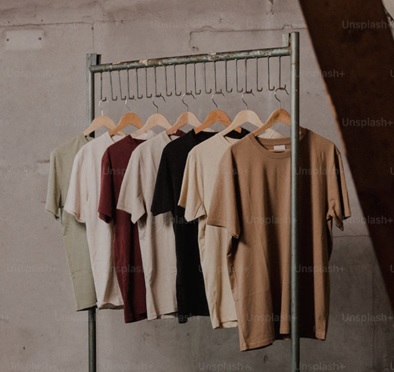Designing t-shirts is a fun and creative way to express oneself. While it may seem daunting to start, it is actually quite easy to design t-shirts. With the right tools and mindset, anyone can create a unique and personalized t-shirt. In this article, we will explore the steps to designing t-shirts and provide tips to help you get started.
The first step in designing t-shirts is to come up with a concept. This can be a phrase, image, or design that you want to showcase on your shirt. Once you have a concept, you can start to sketch out ideas and create a rough draft of your design. It is important to keep in mind the size and placement of your design, as well as the color of the shirt you plan to use.
After you have a rough draft of your design, it is time to bring it to life. This can be done through various methods such as screen printing, heat transfer, or direct-to-garment printing. Each method has its own advantages and disadvantages, so it is important to research and choose the method that best fits your needs. With these basic steps in mind, you can start designing your own t-shirts and express your creativity in a fun and unique way.
1. Identifying Your Target Audience
2. Creating Your Design
3. Choosing the Right Materials
4. Dealing with Shipping and Inventory
5. Marketing Your T-Shirt Business
6. Evaluating Your Business Success
Identifying Your Target Audience
When designing t-shirts, it’s important to have a clear understanding of who your target audience is. Identifying your target audience will help you create designs that resonate with them, resulting in higher sales and customer satisfaction.
To begin identifying your target audience, consider the following questions:
- Who is most likely to wear your t-shirts?
- What age range are they in?
- What is their gender?
- What are their interests and hobbies?
- What is their lifestyle like?
- What is their income level?
Answering these questions will help you create a profile of your ideal customer. Once you have a clear understanding of your target audience, you can begin designing t-shirts that will appeal to them.
For example, if your target audience is young adults who are interested in music and pop culture, you may want to create designs inspired by popular bands or TV shows. On the other hand, if your target audience is middle-aged professionals, you may want to create designs that are more sophisticated and understated.
By identifying your target audience and creating designs that appeal to them, you can increase the success of your t-shirt business.
Creating Your Design
When it comes to designing a T-shirt, there are a few things you need to consider. The design should be eye-catching, unique, and relevant to your target audience. Here are some steps you can follow to create a T-shirt design that stands out:
- Define your target audience – Before you start designing, you need to know who you are designing for. Consider the age, gender, interests, and lifestyle of your target audience. This will help you create a design that resonates with them.
- Research – Look at what other T-shirt designers are doing. This will help you get inspiration and ideas for your own design. You can also research current trends to see what’s popular.
- Sketch your ideas – Once you have an idea of what you want to create, sketch it out. This will help you visualize your design and make any necessary changes before you start working on the computer.
- Choose your colors – Colors are an important part of any T-shirt design. Choose colors that complement each other and are relevant to your design.
- Use the right software – There are many software options available for T-shirt design. Choose one that you are comfortable using and that has the features you need.
- Get feedback – Once you have created your design, get feedback from others. This will help you improve your design and make any necessary changes.
- Choose a printing service – When you are ready to print your T-shirts, choose a screen printing service that meets your needs. Look for a company that offers high-quality printing, competitive pricing, and excellent customer service.
By following these steps, you can create a T-shirt design that is unique, relevant, and eye-catching. With the right design and printing service, you can create T-shirts that people will love to wear.
Choosing the Right Materials
When it comes to designing t-shirts, choosing the right materials is crucial to achieving the desired look and feel. Here are a few things to consider:
Fabric Type
There are many types of fabrics to choose from, each with its own unique properties. Some common options include:
- Cotton: A popular choice due to its softness and breathability.
- Polyester: Known for its durability and resistance to wrinkles and shrinking.
- Rayon: A lightweight, silky fabric that drapes well.
- Linen: A breathable, lightweight fabric that is great for warm weather.
Consider the look and feel you want for your t-shirt and choose a fabric that will help you achieve that.
Fabric Weight
The weight of the fabric can also impact the look and feel of your t-shirt. Lighter weight fabrics are typically softer and more breathable, while heavier fabrics offer more structure and durability.
Color
When choosing materials for your t-shirt, consider the color you want to achieve. Some fabrics are better suited for certain colors than others. For example, cotton is great for achieving vibrant, bright colors, while polyester is better for darker, more saturated colors.
Texture
The texture of the fabric can also impact the overall look and feel of your t-shirt. Some fabrics have a smooth, silky texture, while others have a more textured, rough feel. Consider the texture you want for your t-shirt and choose a fabric that will help you achieve that.
By considering these factors when choosing materials for your t-shirt design, you can create a product that looks and feels great.
Marketing Your T-Shirt Business
Marketing is a crucial aspect of any business, and the t-shirt business is no exception. To ensure the success of your t-shirt business, you need to have a solid marketing plan in place. Here are a few tips on how to market your t-shirt business:
- Create a strong brand: Your brand is what sets you apart from the competition. Make sure you have a strong brand identity that resonates with your target audience. This includes your logo, color scheme, and overall aesthetic.
- Leverage social media: Social media is a powerful tool for marketing your t-shirt business. Use platforms like Instagram, Facebook, and Twitter to showcase your designs, engage with your audience, and drive traffic to your website.
- Partner with influencers: Influencer marketing can be a great way to reach a wider audience. Look for influencers in your niche who have a strong following and engage with their audience. You can offer them free t-shirts in exchange for promotion on their social media channels.
- Attend events: Trade shows, pop-up shops, and other events are great opportunities to showcase your designs and connect with potential customers. Make sure you have plenty of business cards and promotional materials on hand.
- Offer promotions: Everyone loves a good deal. Offer promotions like buy-one-get-one-free or discounts for first-time customers to entice people to try your t-shirts.
By following these tips, you can create a strong marketing plan that will help your t-shirt business succeed.
Dealing with Shipping and Inventory
When it comes to designing and selling t-shirts, dealing with shipping and inventory is an important aspect that should not be overlooked. Here are a few tips to help you manage these aspects effectively:
Firstly, it is important to have a clear idea of your shipping and handling costs. This includes not only the cost of shipping the t-shirts to your customers but also the cost of packaging materials and any handling fees that may apply. Make sure to factor in these costs when setting the price for your t-shirts.
Secondly, it is important to have a system in place for managing your inventory. This includes keeping track of how many t-shirts you have in stock, how many you have sold, and how many you need to reorder. This can be done manually or using inventory management software.
Thirdly, consider using a third-party logistics provider (3PL) to handle your shipping and inventory needs. This can save you time and money by outsourcing these tasks to a specialized company.
Lastly, make sure to communicate clearly with your customers about shipping times and any potential delays. This will help to manage expectations and ensure customer satisfaction.
By following these tips, you can effectively manage your shipping and inventory needs while focusing on designing and selling high-quality t-shirts.
Evaluating Your Business Success
When designing t-shirts, it’s important to evaluate your business success to determine if your designs are resonating with your target audience. Here are a few key factors to consider:
Sales
The most obvious way to evaluate your success is by looking at your sales numbers. Are your designs selling well? Are certain designs selling better than others? Analyzing your sales data can help you identify which designs are most popular and which ones may need to be revised or discontinued.
Customer Feedback
Another important factor to consider is customer feedback. Are customers leaving positive reviews or comments about your designs? Are there any common complaints or criticisms that you should address? Paying attention to customer feedback can help you improve your designs and better meet the needs of your target audience.
Brand Awareness
Brand awareness is also important when evaluating your success. Are people talking about your brand on social media or other platforms? Are your designs being shared or reposted by influencers or other popular accounts? Tracking your brand’s online presence can help you gauge how well your designs are resonating with your target audience.
Competition
Finally, it’s important to consider your competition when evaluating your success. Are your designs standing out from the competition? Are there any gaps in the market that you could fill with your designs? Analyzing your competition can help you identify areas where you can improve and differentiate your brand from others in the market.




















